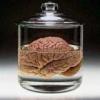heres my really naive look at something not even as advanced as jensens paper.

So, this will make it more realistic.
I compute E, as a write this instead of just ordinarily lighting the model before i blur it, this is actually standing for how much energy actually goes into the model.
only thing i dont understand is the dwi bit at the end, which is differentiation, what does that mean?
Then when im computing the subsurface scattering, i compute the dipole approximation for each sample of "e" (which gets you "b") thats in the neighbourhood of x0 (the exiting pixel, or target pixel) this is also ending in dxi and it has that funny sign at the start... does this mean summing the points and averaging by the amount wont work?
so basicly its fresnel in, dipole, fresnel out (and do you sum it??), and thats more realistic subsurface scattering, but I dont understand, could someone help me out?
As you can see, a basic summing of the reflectance of the model is a blur, but thats nothing like this, you actually compute transmitting light, then you use a dipole approximation which has neat variables in it to change the scattering, even takes into account the fact only some of the light from xi will even reach x0, then you fresnel it at the end as it exits x0 to the eye (to get from "b" to "l"). and you somehow "sum" all the results from all the samples, but its not a sum sign, its an integration with a d at the end, so what the hell do you do with that?!?!?
I get the basic gist, but not a real understanding so I could implement it.










